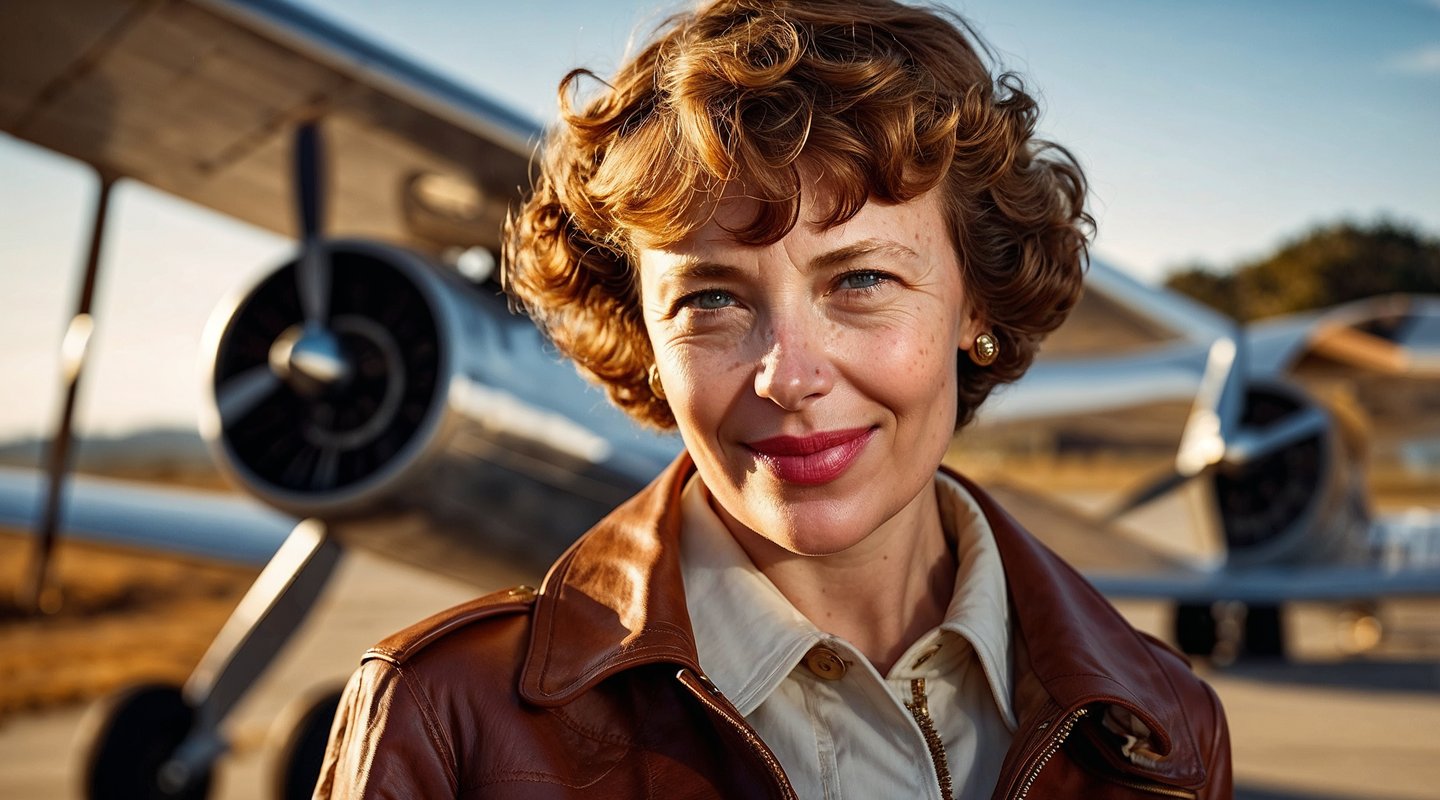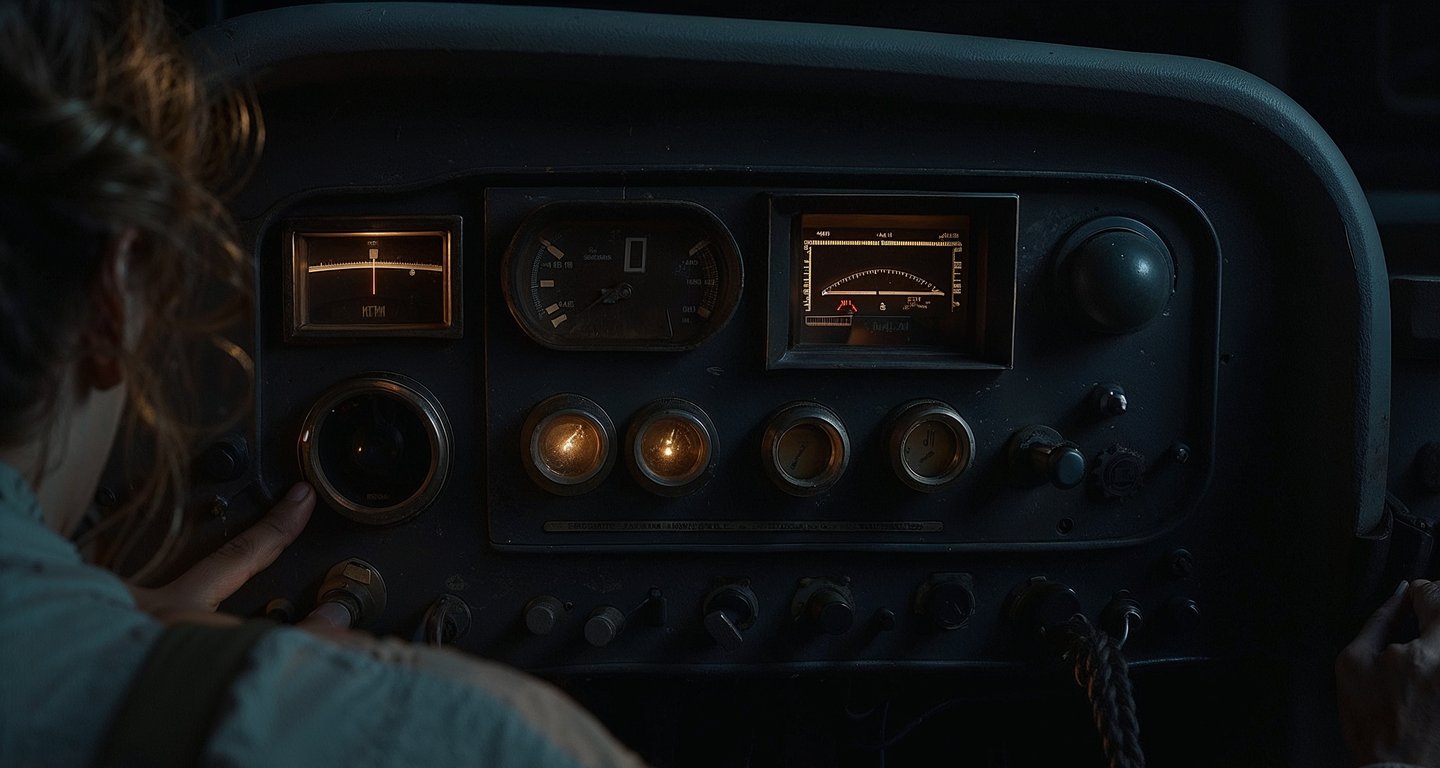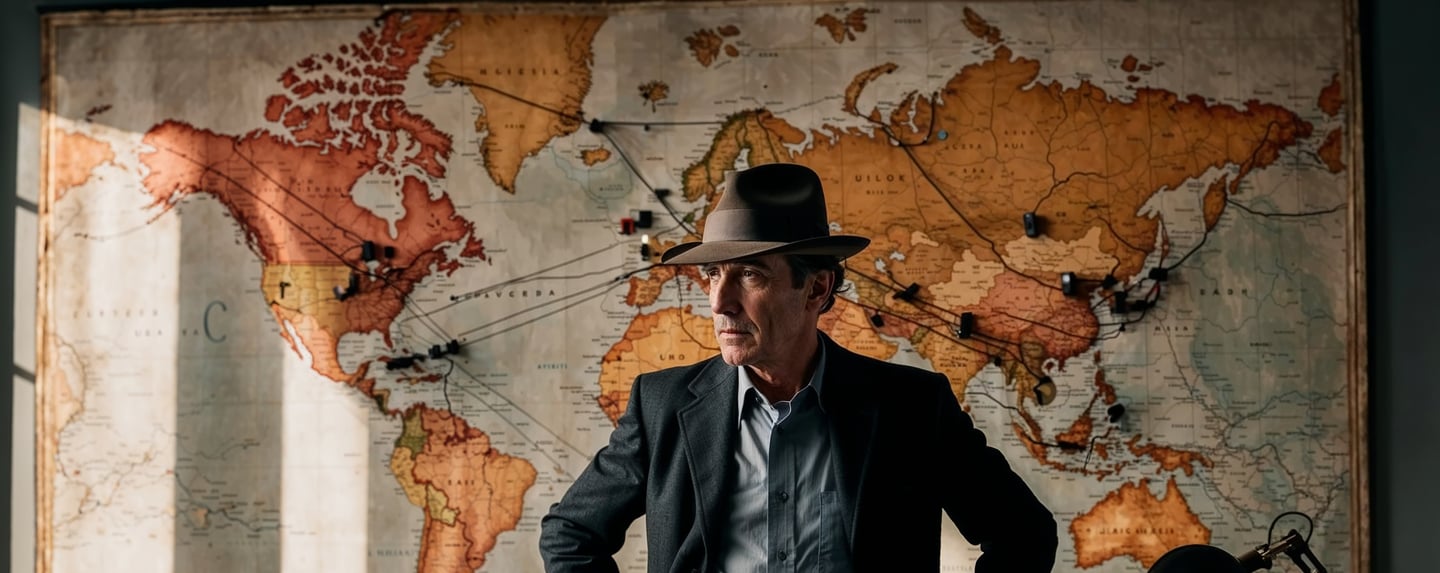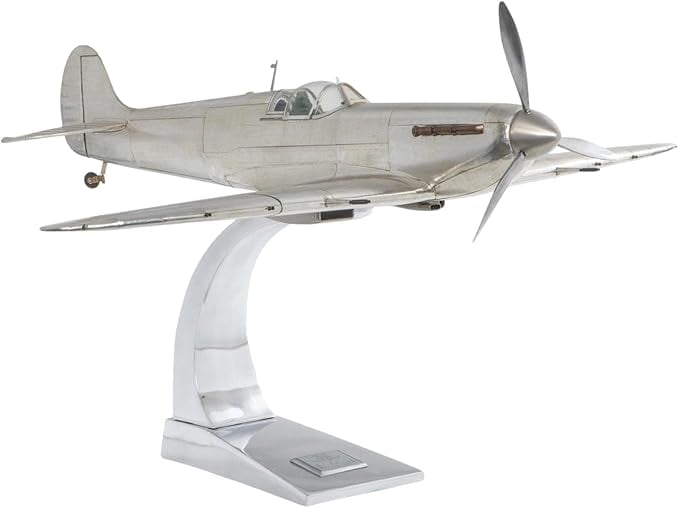Amelia Earhart
Explore the life and mysterious disappearance of Amelia Earhart, one of aviation's most iconic pioneers. In this blog, we dive into her groundbreaking achievements, the theories surrounding her final flight, and the legacy she left behind. From her historic solo Atlantic crossing to the theories of her fate, discover how Earhart's fearless spirit continues to inspire and captivate the world. Join us as we unravel the enduring mystery of her disappearance and honor her incredible contributions to history.
HISTORICAL FIGURESEXPLORATIONHISTORIC EVENTS
Michael Keller
12/16/202414 min read
Taking Flight
Amelia Earhart soared above the boundaries of her time, a pioneer who defied expectations and charted new paths through the skies. Her adventurous spirit captivated the world, and her daring feats sparked imaginations far and wide. But beneath the triumphs, there was a story of relentless ambition and an unyielding desire to conquer the unknown. What drove this fearless aviator? And what secrets did she carry with her into the great expanse of the sky? Join us as we explore the extraordinary life of Amelia Earhart.
A Spirit Born to Soar
Amelia Mary Earhart was born on July 24, 1897, in Atchison, Kansas. [1] From the start, she seemed destined to carve her own path. Her family affectionately called her "Meeley," a nickname that captured the lighthearted, free-spirited nature she carried through her entire life. [2] Even as a child, Amelia didn’t fit the typical mold of a young girl in the late 1800s. While others were content with dolls or playing house, she was more likely to be found climbing trees, exploring the woods, or riding her bike as fast as she could.
Her curiosity knew no bounds, and it was this sense of wonder that often led her to the most unexpected places. She once created a makeshift ramp to launch her bike off a hill, convinced it could fly. [3] Spoiler alert: it didn’t. But rather than giving up, Amelia simply dusted herself off, laughed, and tried again. It’s this determination that would define her in the years to come.
Amelia's childhood wasn't without its challenges. Her family’s financial struggles meant that she and her sister, Muriel, had to adapt to a life that wasn’t always easy. [4] But even in these moments, Amelia’s spirit was unbreakable. She was fiercely independent, and from an early age, she understood the power of determination and resilience. She didn't wait for opportunities to come to her; she sought them out, often with a sense of adventure that made others wonder if she had a secret plan to change the world.
Her childhood wasn’t just about adventure, though. It was also about growing into the person who would take on the world in ways no one had seen before. The foundations for her daring flights, her boundless ambition, and her unyielding drive were all laid in those formative years in Atchison. And as she continued to grow, there was no limit to where those traits would take her.




From Service to Sky
After graduating from high school, Amelia’s path wasn’t immediately clear. The world was in the throes of World War I, and while many young men were heading off to war, Amelia found herself contributing in a different way. She became a nurse’s aide in Toronto, Canada, where she worked tirelessly to care for wounded soldiers. [5] It wasn’t the adventure she dreamed of, but it was a service that reflected her deep sense of duty. Amelia’s time there left a lasting impression on her; she witnessed firsthand the fragility of life, and it only fueled her determination to chase after her dreams with even greater intensity.
When the war ended, Amelia, like many, had to find her footing in a world that was quickly changing. She worked a variety of jobs, from a social worker helping the underserved to a truck driver, but none of them fully satisfied her thirst for something more. Her restless energy led her to take a significant step, a step that would ultimately change her life forever. In 1920, Amelia attended a flying exhibition at Long Beach, California. It was there, as she watched pilots perform daring stunts, that she realized her calling.
The idea of flight had always intrigued her, but it wasn’t until that moment that she understood how profoundly it would shape her future. Amelia took her first flying lesson in 1921, under the guidance of instructor Max F. Harling. [6] At first, she was understandably nervous. The skies were uncharted for her, both literally and figuratively. But as soon as she was airborne, she felt an exhilarating sense of freedom. [7] It was as though the ground beneath her no longer held her, and she was weightless in a world of possibility. The feeling was electric. She immediately knew this was where she belonged.
Her time in the air wasn’t always smooth, but Amelia’s resilience came through in every challenge. She learned quickly and threw herself into aviation with the same determination that had fueled her childhood adventures. There was something about the rush of the wind and the quiet of the skies that spoke to her soul. She was no longer just an ordinary woman; she was an aviator, a woman who had found her wings.
Into the Unknown
Amelia Earhart was always chasing the horizon, never satisfied with the limits of the known world. On July 2, 1937, she pushed the boundaries of human exploration further than ever before, into a realm from which she would never return. [16] After crossing continents, flying solo across the Atlantic, and setting numerous records, Amelia was attempting her greatest challenge yet: a flight around the world. Her specially modified Lockheed Electra 10E was designed to conquer the vast distances ahead, and the world watched in awe as she prepared for this monumental journey, her heart set on making history once again. [17]
But something went terribly wrong. Amelia's last transmission, received at 8:43 a.m. local time, came as she was navigating toward Howland Island, a small speck of land in the Pacific. [18] After that call, nothing. Silence. In the blink of an eye, the woman who had defied odds and soared through the skies was gone, swallowed by the vastness of the ocean.
What followed was a search effort unlike anything the world had ever seen. The U.S. Navy and Coast Guard launched a massive operation, covering over 250,000 square miles of ocean in hopes of finding Amelia or her plane. [19] The days turned into weeks, and yet, no trace of her or her aircraft was found. Her disappearance sparked global grief and disbelief. People were left mourning not only a pioneering woman in aviation but a symbol of hope, courage, and the boundless possibilities of the human spirit. In the end, even the sky seemed to refuse to hold her.
As the search was called off and the months passed, the questions surrounding her fate only deepened. Amelia’s story, already one of triumph and daring adventure, became a riddle, a mystery that would never be solved.
Theories of the Disappearance
In the years that followed, as the search for Amelia Earhart came to an agonizing halt, speculation about her disappearance grew. Theories emerged, each more captivating than the last, as people tried to make sense of what had happened to her and her navigator, Fred Noonan.
One of the most widely discussed theories suggests that Amelia and Fred crash-landed on a remote, uninhabited island in the Pacific. [20] Gardner Island, now known as Nikumaroro, became the focal point of this idea. According to this theory, after running out of fuel, Amelia and Fred made an emergency landing on the small island, hoping for rescue. With no provisions and little hope, they used makeshift distress signals and even attempted to survive by setting up a rudimentary camp. Though various expeditions have uncovered possible clues, (fragments of wreckage, items that might have belonged to humans) no conclusive evidence has been found. [21] Still, the theory persists, fueled by tantalizing bits of evidence suggesting they might have survived on the island for some time.
Another theory that kept the mystery alive was the possibility that Amelia and Fred had been captured by the Japanese. [22] This theory gained traction during World War II, as some speculated that the aviators, lost in the vast expanse of the Pacific, accidentally flew into Japanese-controlled territory. According to this theory, they were taken as prisoners, either treated as spies or held captive. Though there is little evidence to support this idea, it remained in the public’s imagination as a more dramatic explanation. [23]
There are also more exotic theories, like the notion that Amelia staged her own disappearance, vanishing into a new life under an assumed identity. Some believe she may have been part of a covert espionage mission and that her disappearance was orchestrated by the U.S. government for reasons that remain unclear. Though these theories have been largely debunked, they continue to spark intrigue, especially for those who refuse to accept the more straightforward explanations. [24]
The fact that no definitive evidence has ever been found only deepens the mystery. Despite years of searches and countless theories, the truth about Amelia Earhart’s fate remains elusive. In many ways, the uncertainty surrounding her disappearance has become as much a part of her story as her incredible achievements. The questions linger, fueling the fascination with the daring aviator who set out to conquer the skies, and then vanished without a trace.
Amelia Earhart (1897-1937) captured the imagination of America when she became the first woman to fly across the Atlantic in 1928. Nine years later, her disappearance during an around-the-world flight marked a tragic and mysterious end to her remarkable journey. Drawing on a decade of in-depth archival research, including Earhart’s letters, journals, and diaries, as well as interviews with her friends and family, East to the Dawn offers the most comprehensive and nuanced portrayal of her life. It delves into her record-setting aviation career, personal relationships, and early years with her grandparents. The book also explores her experiences as a nurse and social worker, her iconic marriage to publisher George Putnam, and her secret affair with Gene Vidal, head of the Bureau of Air Commerce. As the Los Angeles Times praised, East to the Dawn is a "fully realized portrait of a truly remarkable woman.”
Breaking Barriers
Amelia Earhart’s name began to spread, not just in aviation circles, but across the world. In 1928, she achieved something truly remarkable: she became the first woman to fly across the Atlantic Ocean. [8] Though she didn’t pilot the plane herself, she was a passenger, alongside pilot Wilmer Stultz and copilot Louis Gordon, the flight made her an international sensation. The world was captivated by her boldness, her courage, and the new possibilities she represented for women in a time when such feats were considered impossible for them.
But Amelia wasn’t content with simply being the “first woman to do this or that.” She wasn’t after the fame or the accolades. She was driven by a deeper passion, one that was sparked during those first flying lessons years earlier. Aviation, to Amelia, wasn’t just about breaking records or gaining recognition, it was about pushing the boundaries of what was possible and inspiring others to do the same. In 1931, she set an altitude record for autogyros. [9] The autogyro, a precursor to the modern helicopter, was a significant aviation challenge at the time. Amelia reached 14,000 feet, proving her skill and determination in a field dominated by men. [10]
By now, Amelia had already written her first book, 20 Hrs., 40 Min., detailing the flight across the Atlantic and her experiences as a woman in aviation. [11] But it wasn’t just the facts she shared, it was her voice, her personality. Through her writing, readers could hear her humor, her humility, and her unrelenting drive. She spoke honestly about the challenges she faced as a woman in a male-dominated industry. And in doing so, she became not just a pilot, but a role model, an inspiration for countless women who had long been told that certain dreams were beyond their reach.
Her fame continued to grow, but Amelia didn’t allow it to overshadow her ambitions. In 1932, she became the first woman to fly solo nonstop across the Atlantic, taking off from Newfoundland and landing in Ireland. [12] This flight wasn’t just another achievement; it was a statement. Amelia was proving to the world that women weren’t confined by limits. She wasn’t just participating in the world of aviation; she was changing it.
As her fame grew, so did the opportunities to make a real difference. But with each success, Amelia faced challenges that required not only skill, but also grace under pressure. The weight of expectations could have easily pulled her down, but Amelia seemed only to rise higher in the face of it all. There was something about her, her confidence, her quiet determination, that made people believe she could accomplish anything she set her mind to.
But what truly stood out about Amelia was her ability to inspire. She was always ready to share her story, encouraging others to chase their dreams no matter how impossible they seemed. She spoke of the challenges she faced as if they were just another part of the adventure. And the world listened. For many, she became the embodiment of the idea that anything was possible if you were willing to fight for it.
The World at Her Wings
As Amelia Earhart’s career soared, so did her list of record-breaking flights, each one further proving that she was no ordinary pilot. She wasn’t just flying for the sake of it, she was flying to prove a point, to show that women were just as capable as men in a world that often said otherwise. She had already shattered so many barriers that now she was simply pushing herself further, seeking new ways to push the boundaries of aviation and human endurance.
Her flights were not just physical feats, they were symbolic. She often said that her love for aviation wasn’t about the thrill of flying, it was about the thrill of making the impossible possible. Each new record was a testament to her drive, but also to her ability to inspire others, especially women who looked up to her as a symbol of empowerment. Amelia was showing them that no dream was too big, no goal too distant. She wasn’t just navigating the skies; she was navigating a world that was still finding its way to equality.
Through her second book, The Fun of It (1932), she revealed more of her personality, her wit, and the joy she took in every new adventure. [13] In her words, the true reward of aviation wasn’t the accolades or recognition, it was the joy of discovery. “Adventure is worthwhile in itself,” she wrote, a sentiment that summed up her entire approach to life. [14] Every flight she took was another adventure, another opportunity to discover the world in a way that few others ever would.
In 1935, she set a new speed record for a flight from Los Angeles to Mexico City, a feat that pushed both herself and her aircraft to the brink. [15] Yet, despite the accolades and her fame, Amelia remained remarkably humble. She wasn’t out for glory or to cement her name in history, she was in love with the challenge, with the freedom of flight, and with the idea of showing others that they too could achieve their dreams. But in each of her accomplishments, there was something more, an unspoken invitation to others to take flight in their own way, to take the risks, to chase the impossible.
What are your thoughts on Earhart’s life and disappearance? Do you believe the mystery will ever be solved?
Share your thoughts with us. For feedback or inquiries, email: contact@archivinghistory.com. We look forward to hearing from you!
Join Archiving History as we journey through time! Want to stay-tuned for our next thrilling post? Subscribe!
Follow us on Facebook, Instagram, YouTube and TikTok for captivating insights, engaging content, and a deeper dive into the fascinating world of history.
Source(s):
1. Long, Elgen M., and Marie K. Long. Amelia Earhart: The Mystery Solved. New York: W.W. Norton & Company, 1999. Page 12.
2. Lovell, Mary S. The Sound of Wings: The Life of Amelia Earhart. New York: St. Martin's Press, 1989. Page 20
3. Long, Elgen M., and Marie K. Long. Amelia Earhart: The Mystery Solved. New York: W.W. Norton & Company, 1999. Page 115
4. Lovell, Mary S. The Sound of Wings: The Life of Amelia Earhart. New York: St. Martin's Press, 1989. Page 130
5. Brown, Susan Ware. Amelia Earhart: A Biography. New York: W.W. Norton & Company, 1998. Page 150
6. Long, Elgen M., and Marie K. Long. Amelia Earhart: The Mystery Solved. New York: W.W. Norton & Company, 1999. Page 190
7. Earhart, Amelia. 20 Hrs., 40 Min. New York: Harcourt Brace, 1928. Page 195
8. Lovell, Mary S. The Sound of Wings: The Life of Amelia Earhart. New York: St. Martin's Press, 1989. 240
9. Brown, Susan Ware. Amelia Earhart: A Biography. New York: W.W. Norton & Company, 1998. Page 310
10. Brown, Susan Ware. Amelia Earhart: A Biography. New York: W.W. Norton & Company, 1998, Page 260
11. Earhart, Amelia. 20 Hrs., 40 Min. New York: Harcourt Brace, 1928.
12. Lovell, Mary S. The Sound of Wings: The Life of Amelia Earhart. New York: St. Martin's Press, 1989. Page 240
13. Earhart, Amelia. The Fun of It. New York: Putnam, 1932. Page 250
14. Earhart, Amelia. The Fun of It. New York: Putnam, 1932. Page 265
15. Brown, Susan Ware. Amelia Earhart: A Biography. New York: W.W. Norton & Company, 1998. Page 360
16. Brown, Susan Ware. Amelia Earhart: A Biography. New York: W.W. Norton & Company, 1998. Page 410
17. Lovell, Mary S. The Sound of Wings: The Life of Amelia Earhart. New York: St. Martin's Press, 1989. Page 415
18. Brown, Susan Ware. Amelia Earhart: A Biography. New York: W.W. Norton & Company, 1998. Page 440
19. Lovell, Mary S. The Sound of Wings: The Life of Amelia Earhart. New York: St. Martin's Press, 1989. Page 460
20. Gillespie, Ric, and Jeanette Bell. "Amelia Earhart: The Search for Her Final Resting Place." National Geog raphic, 2007. Page 510
21. Gillespie, Ric. "Amelia Earhart's Disappearance: The Search for Evidence." Smithsonian Channel, 2019. Page 535
22. Smith, Laura. Amelia Earhart: The Truth Behind the Mystery. New York: HarperCollins, 2000. Page 515
23. Smith, Laura. Amelia Earhart: The Truth Behind the Mystery. New York: HarperCollins, 2000. Page 540
24. Lovell, Mary S. The Sound of Wings: The Life of Amelia Earhart. New York: St. Martin's Press, 1989. Page 555
25. Earhart, Amelia. 20 Hrs., 40 Min. New York: Harcourt Brace, 1928. Page 265


Indulge in the authenticity of this model plane, meticulously crafted with polished aluminum for collectors and aviation enthusiasts. Measuring at 29.9" x 24.4" x 18.1", this replica is a timeless addition to any scale model aircraft collection.
Amelia Earhart (1897-1937) captured the imagination of America when she became the first woman to fly across the Atlantic in 1928. Nine years later, her disappearance during an around-the-world flight marked a tragic and mysterious end to her remarkable journey. Drawing on a decade of in-depth archival research, including Earhart’s letters, journals, and diaries, as well as interviews with her friends and family, East to the Dawn offers the most comprehensive and nuanced portrayal of her life. It delves into her record-setting aviation career, personal relationships, and early years with her grandparents. The book also explores her experiences as a nurse and social worker, her iconic marriage to publisher George Putnam, and her secret affair with Gene Vidal, head of the Bureau of Air Commerce. As the Los Angeles Times praised, East to the Dawn is a "fully realized portrait of a truly remarkable woman.”




A Pioneer Remembered, A Mystery Unsolved
Amelia Earhart’s life continues to be a beacon of inspiration, her fearless spirit lighting the way for those who dare to go beyond the limits of possibility. She didn’t just break barriers in aviation; she reshaped what was possible for women in every field. Whether it was flying solo across the Atlantic or setting altitude records, Amelia proved that no sky was too vast, no mountain too big. And yet, it’s not just her record-breaking feats that have left a lasting impact, it's her audacity, her relentless drive to push forward, even in the face of overwhelming odds.
Her disappearance in 1937 only fueled her mystique, becoming as much a part of her legend as her daring achievements. It’s a mystery that continues to captivate the world, and despite decades of theories and speculation, Amelia's fate remains one of history’s greatest unanswered questions. But the truth remains: Amelia Earhart’s contributions to history were as boundless as her dreams.
Her words, found in her book 20 Hrs., 40 Min., continue to echo through time, inspiring generations: “The most difficult thing is the decision to act, the rest is merely tenacity.” [25] These words capture the essence of who Amelia was, a woman who faced every challenge head-on, never allowing fear or doubt to stand in her way.
Though her final flight remains unsolved, her legacy is clear. Amelia Earhart’s pioneering spirit endures, reminding us all that some dreams are worth chasing, even into the unknown. Her life was a testament to the power of ambition, courage, and perseverance, and even in her absence, she continues to inspire us to reach for the sky.








